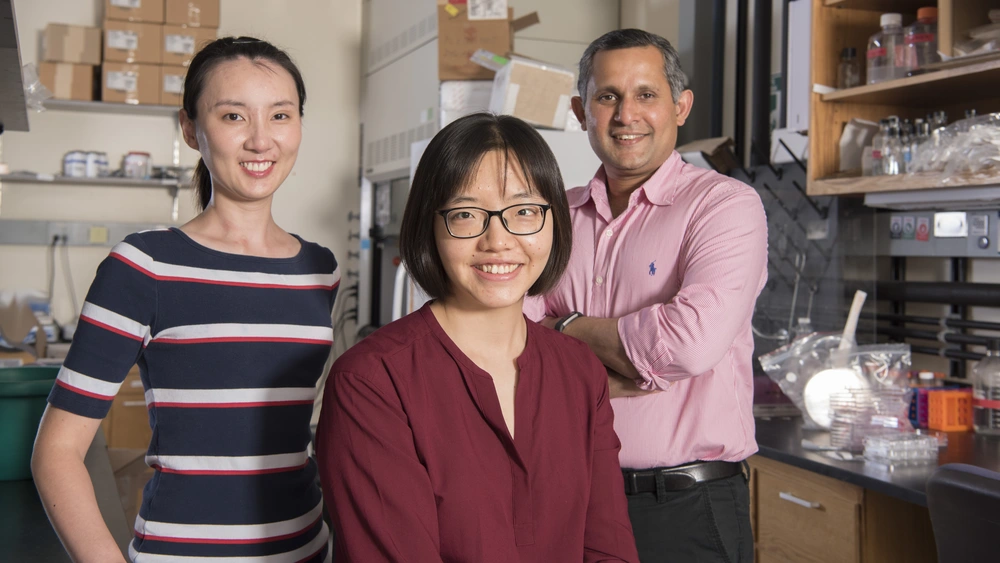
If the human genome is a blueprint, for many years proteins have been considered to be the final manufactured products that carry out cell processes. Historically, most research labs have focused on the two percent of the human genome that codes for protein. The role of the remaining non-coding regions has started to gain attention only in the last few decades.
A large fraction of these non-coding regions give rise to long non-coding RNAs or lncRNAs. “Our lab has been focused on lncRNAs for years, said Qinyu Sun, a graduate student in the Prasanth lab. “Although they do not code for protein, they have important roles in many important biological processes,” she said.
“For the longest time, lncRNAs were considered to be non-functional sequences,” said Prasanth, Associate Professor in the Department of Cell and Developmental Biology. “The development of advanced techniques, for instance, next-generation-sequencing (NGS) has helped us to identify novel lncRNAs in human cells. We now know that human genome contains more than 20,000 lncRNA genes. Even if half of them are functional, that is a significant number.”
“Our lab is interested in studying the role of lncRNAs in cell cycle progression and their involvement in cancer progression. I am specifically interested in determining the role of a specific subset of lncRNAs that encode microRNAs in cell cycle progression,” said Sun. MicroRNAs are much smaller than lncRNAs (20-22 nucleotides vs >200 nucleotides). Therefore, the sequence of a single lncRNA can house the several microRNAs within its exons or intronic regions, earning these lncRNAs the name “microRNA host genes” or MIRHGs.
According to Sun, “Researchers usually focus on microRNAs and their roles, and completely ignore the possibility of the MIRHG playing microRNA-independent functions,” she said. “However, our work has shown that lncRNAs can work independently of the microRNAs that they encode.” Prasanth added, “It was, in general, believed that once the microRNAs were produced, the rest of the lncRNA was degraded. That is why the microRNA-independent functions were ignored.”
This new research focused on the role a particular lncRNA, MIR100HG, during the cell cycle progression. “The cell exhibits distinct phases in its lifetime. For each phase, the population of genes and proteins that are expressed differs. We were initially interested in seeing whether MIRHG, including MIR100HG showed differential expression based on the cell cycle stage,” explained Prasanth.
“We saw that MIR100HG is highly expressed during G1 phase when the cells are preparing to replicate their DNA. Interestingly, when we looked at the microRNAs encoded by MIR100HG, their levels remained unchanged, indicating that the lncRNA potentially has a microRNA-independent role during the cell cycle,” said Sun.
The high expression of MIR100HG during cell cycle or proliferation has important implications. “First, our findings prove that this lncRNA is important during cell cycle progression. Second, MIR100HG could be used as a diagnosis marker for cancer. We can check if its levels are higher in cancer vs non-cancer cells and whether the levels differ based on the cancer type,” said Sun.
The findings of the paper are novel because the lab has dissected the function of the lncRNA. “We prepared the full length MIR100HG without the microRNA components and looked at what proteins it can interact with. By doing so we gained key insights into its role in the cell cycle,” said Sun.
MIR100HG interacts with HuR, a protein that is known to act as a post-transcriptional or translational regulator of RNA molecules and is also shown to regulate cell cycle. MIR100HG-HuR interaction facilitates the binding of HuR to its RNA target mRNAs, including that of several cell cycle regulatory genes (cyclin D), indicating that MIR100HG regulates HuR activity by acting as a scaffold for the interaction.
The paper fits into the long-term goal of the lab, which is to understand the role of lncRNAs during the cell cycle. “The function of lncRNAs can be extrapolated to understand their role in disease progression. Our lab looks at breast cancer specifically and we want to understand which lncRNAs, play key roles in cancer progression,” said Prasanth.
“My interest in lncRNAs started from my undergraduate experiences,” said Sun. “Every lncRNA candidate is novel. Even a particular lncRNA such as MIR100HG might execute distinct functions in various cell types or cancer conditions by modulating the activity of different subset of proteins. I also want my research to contribute to public health and help find a better way of treating cancer.”
